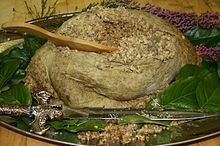What is haggis? It is made with sheep intestines and with offal, that is, the entrails and internal organs of an animal used as food. To be more precise, a sheep’s heart, liver, and lungs are mixed with onion, oatmeal, suet, salt, stock, and spices. These items are blended together inside the casing of a sheep’s stomach. I know what you’re thinking right now: Don’t stop! There must be more! As obviously squeamish to the uninitiated it may be but remember how hot dogs are made… today. Or a Big Mac. Being Scottish doesn’t hurt. In the very distant past, the 1400s, making food did not involve a convection oven or gas stove. Mainly because they weren’t invented yet. So, all parts of an animal were cooked or boiled. Nothing goes to waste. Even today plenty folk love eating liver and onions. That’s calf’s liver, people.
The haggis is quite tasty, like a spicy meat. If you were to taste it without knowing its cooking properties, and a carnivore, you would think the same.
Haggis is well-known around the world as it is a delight at Burns Suppers. It is presented at a feast in honour of Scottish poet, Robert (Rabbie) Burns (he of Auld Lang Syne fame), whose birthday on January 25, these suppers are held on or about that date. His poem, “Address to a Haggis”, is read out as the haggis is offered to the guests. The history of its making is claimed to go as far back as Homer’s Odyssey, but its recipe was found in the 1400s written by English-types. However, no one today would deny its proper homeland.
Go to this website if you want to have a go and/or really interested in how it is prepared from start to finish: https://www.bbc.co.uk/food/recipes/haggis_66072
https://theculturetrip.com/europe/united-kingdom/scotland/articles/history-scottish-haggis/ https://www.bbc.co.uk/food/recipes/haggis_66072 https://www.britannica.com/topic/haggis https://www.historic-uk.com/HistoryUK/HistoryofScotland/Haggis-Scotlands-National-dish/


Something everyone should try …. once!